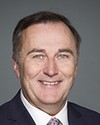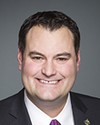Thank you for the invitation to be here today to give my perspective on the delivery of service to veterans.
As ombudsman to the Department of National Defence and the Canadian Armed Forces, my office is completely independent of both military and civilian chains of command, reporting directly to the Minister of National Defence. As an evidence-based, neutral organization, we do not advocate for any particular group. However, we do advocate for fairness, to ensure that any process or policy inside the department treats the members, both military and civilian, fairly.
Part of my constituency base is former members of the Canadian Armed Forces. If their issues involve the Canadian Armed Forces, they utilize the services of my office. If their issues have to do with receipt of benefits or services from Veterans Affairs, they utilize the Office of the Veterans Ombudsman.
As you would expect, with overlapping constituents, our two offices work well together. In fact, several members from my office have worked at the ombudsman's office and vice versa, including me. I spent three years there as deputy ombudsman.
Of the approximately 200,000 veteran clients at Veterans Affairs, we don't hear from all of them. We hear from the ones who slip through the cracks. Seamless transition for most ill or injured military members who require benefits and services remains a concept, not a reality, and is fraught with painstaking challenges.
Efforts to reduce complexities in service delivery have not provided the desired outcomes. Many of the available programs and services are overlapping. Others are frustratingly hard to navigate. For example, the Department of National Defence and the Canadian Armed Forces, Veterans Affairs Canada, and SISIP, the insurance provider, all have their own case managers and their own vocational and rehabilitation programs.
Some of the offered programs become inaccessible through the sheer lack of awareness of the eligibility criteria. It would be best to have one knowledgeable point of contact that you can trust for the entire journey.
It is no secret that there are endless forms and long delays in adjudication. Paperwork, and lots of it, remains the primary method to obtain services and benefits from Veterans Affairs. At present, a file is transferred from the Department of National Defence to Veterans Affairs and then goes for adjudication while the member waits. In some cases, this could be for an extended period of time if there are complexities or nuances with the file. As far as adjudication goes, it is not, in my opinion, acceptable that there is a 16-week service delay.
I believe that all the evidence we need for the determination of attribution of service sits within the Canadian Armed Forces. Before they release a member, they work with them for an extended period of time, depending on the injury or malady. We know where, when, and how the soldier has become ill or injured. In my opinion, everything should and can be done before the member leaves the service.
One step to make life easier would be to start with the determination of service attribution. I think the biggest stumbling block, if we want to talk about ease of transition and access to care, probably starts right there.
I firmly believe that the Canadian Armed Forces are responsible to the member while they wear the uniform. I do believe that if the Surgeon General's office determines the service attribution, Veterans Affairs can deliver their programs based on the needs of the client, considering the injury or malady and the impact on quality of life. I also believe that there will always be a need for adjudication services inside Veterans Affairs Canada, especially for operational stress injuries, which many times manifest themselves later in life.
I routinely ask my staff and challenge them about what a service delivery model would look like. Why do I do that? Because as bureaucracies we have a tendency to search out process-centric solutions vice veteran-centric needs. For example, on the Veterans 20/20 project, the problem is that we're so focused on the project that we're failing to look at the outcomes.
As for ease of transition, as I just mentioned, I'm aware that the department is working very closely with Veterans Affairs Canada on their Veterans 20/20 project, now known as “Care, Compassion, Respect 20/20”. I know that many task forces have been formed and that representatives from both entities participated. I do believe that these types of conversations will help, but I also believe that we're going to have to go back to the basics, back to the core way we do business. A fundamental change to the service delivery model is what is required.
There has been much fanfare about the reopening of offices and hiring additional staff, but I believe we should place as much effort, if not more, on changing the delivery model. Doing the same thing over and over again, as we have in the past, will not provide better results. We must challenge the status quo methods of operating within departments.
My office is engaged in this effort and is currently considering what a new delivery model could look like from a transitioning member's perspective. This product may be of assistance to this committee and should be ready within the next six to 10 weeks.
The last comment I'd like to make, Mr. Chair, concerns the families of these transitioning members. I believe that we can and should do more, whether in it's access to mental health care, respite, or some sort of financial help to assist those who are helping our members to transition. It should be considered in anything we do going forward.
I stand by for your questions.










